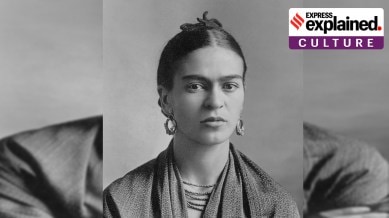Why Frida Kahlo’s self-portraits sell for millions
‘El sueño (La cama)’, or ‘The Dream (The Bed)’, by Kahlo is expected to go for an estimated $40 to $60 million at Sotheby’s upcoming New York sale on November 8. This could make it the most expensive artwork by a woman to be sold at an auction

Frida Kahlo is hardly an artist whose significance can be measured in the millions of dollars that her works fetch. But the fact is, they do.
El sueño (La cama), or The Dream (The Bed), is just the latest work by the Mexican icon to get the international art market go cha-ching.
monthly limit of free stories.
with an Express account.
The 1940 self-portrait is expected to fetch between $40 million and $60 million at Sotheby’s upcoming New York sale on November 8. This could potentially make it the most expensive artwork by a woman to be auctioned, a spot currently held by Georgia O’Keeffe’s Jimson Weed/White Flower No. 1 (1936), which went for $44.4 million at Sotheby’s in 2014.
The eye-popping estimates for El sueño are being attributed to its rarity. “It is one of a few works [by Kahlo] that exists outside of Mexico and not in a museum collection,” noted Julian Dawes, vice-chairman and head of Impressionist and Modern art for Sotheby’s Americas.
More than 50 self-portraits
More than a third of Kahlo’s paintings — 55 of around 150 — are self-portraits. And they are widely popular even today.
The genre of self-portaits, through history, has been a way for artists to introspect and offer viewers a window into the inner recesses of the creative mind. Kahlo’s self-portraits are no exception.
They serve as a visual autobiography of her remarkable 47-year-long life during which she emerged as a feminist icon who transcended the white cube and permeated the lives of ordinary people. She used herself as the subject to both access and address her different realities.
Carrying ‘message of pain’
Kahlo’s life was marked by enduring pain — first because of contracting polio as a child, and then due to a life-altering bus accident that rendered her bed-ridden. She underwent 30 surgeries and was compelled to wear a body cast after the incident.
El sueño captures the reality of her physical agony that finds reflection in the skeleton, entwined in dynamites, that lies on top of her bed canopy, even as she appears to be sound asleep on her bed wrapped in vines. Kahlo was only in her early thirties when she painted this work.
In Kahlo’s own words, her painting “carries with it the message of pain” — both physical and mental. The emotional toll of her turbulent relationship with her husband, fellow artist Diego Riviera, found expression in self-portraits like Diego and I. The 1949 work is her most expensive artwork till date, having fetched $34.9 million in 2021. It also set a new record for a work by a Latin American artist.
Anna Di Stasi, who was then Sotheby’s director of Latin American art, had said that the work was “a painted summary of all of Kahlo’s passion and pain, a tour de force of the raw emotive power of the artist at the peak of her abilities.” Kahlo painted it following her husband’s affair with her close friend, actress Maria Felix.
The painting is a rare self portrait where Kahlo is seen with open hair that appears to wrap around her neck as if strangulating her. A portrait of Riviera sits at the centre of her rebellious unibrow like a third eye. The image encompasses her conflicting state of mind where she feels both suffocated and liberated by her husband, who was among her biggest cheerleaders.
Celebration of identity
Almost every self-portrait painted by Kahlo is a celebration of her identity. That she revelled in where she came from is evident in the Tehuana dresses and the head full of flowers she painted herself in. Self Portrait Along the Border Line Between Mexico and the United States is particularly assertive.
The 1932 work, which she painted during her stay in the US, captures her yearning for her Mexican roots as seen in the Aztec iconography and her homeland’s agrarian culture in contrast to the industrialised US represented in the power plant and skyscrapers in the background. Kahlo stands at the juncture of the two realities with a Mexican flag in hand.
Kahlo was an artist with an active imagination as she transcended the categories of realism and surrealism, but more than that she was a woman with opinions, politics not being an exception. An outspoken Marxist, she advocated the ideology through her art.
In Marxism Will Give Health to the Sick (1954), for instance, she paints herself as the “uplifted” in the Marxist utopia of an egalitarian society. As Marx strangles ‘Uncle Sam’, symbolic of American capitalism, she is able to live a crutch-free life.
El sueño goes under the hammer amid a global art market recalibration. Despite the skepticism over blue chip sales after works by Andy Warhol and Alberto Giacometti were burned lots at auctions earlier this year, it is perhaps collectors’ growing interest in works by women artists in the high-end segment (above $10 million) that stakeholders find reassuring.
The Art Basel and UBS Survey of Global Collecting 2024 noted that “High Net Worth Individuals (HNWIs) spending over $10 million, had devoted a considerably larger 52 per cent of their outlays to female artists”, making Kahlo both a culturally and economically rewarding investment. El Sueño’s auction will not just be a test of Kahlo’s enduring influence but may also set the tone for the future of the global art market.